|
"The "opening of the
mouth ceremony" is arguably the most important ancient Egyptian ritual."--------2002,
Donald B. Redford, "The Ancient Gods Speak: A Guide To Egyptian
Religion" pp. 293-296.
"The peculiar
shape of the blade (fishtail biface)
to resemble a fish tail is typical of knives used, with other tools, for
the ceremony of the "Opening of the Mouth," and would appear much later
in scenes of funeral procession on the walls of the Tomb of the Nobles
in Thebes."------2009,
Abeer el-Shahawy, " Egyptian Museum In Cairo: A Walk Through The
Alleys Of Ancient Egypt,
pp. 17-19.
"---the Sem priest brings an instrument called
the "Pesh-en-kef," and touches the mouth of the mummy or statue
therewith, and says, "O Osiris, I have established for thee two
jaw-bones in thy face, and they are now separated."---------1974?,
first published 1899,
Sir Wallis Budge, "Egyptian Magic," pp. 197-198.
"The
so-called fishtail knives are well documented from the Predynastic
Naqada I-II period (4000-3300 B.C.) and were further used until the
beginning of Naqada III times (ca. 3300-3050 B.C.)."---------2009,
Marquardt Lund, "Egyptian Flint Work, Part III," Chips, Vol. 21,
#3, pp. 5-7.

FISHTAIL BIFACES
PREDYNASTIC PERIOD
EGYPT
Fishtail bifaces are a rare form of stone tool
that had a religious function. Originally they were thought to be spear
points before the discovery of a hafted specimen showed that the concave
end faced outward while the pointed end was embedded in the handle. They were used in what has been described
as possibly the most important ancient Egyptian ritual, known as the
"Opening of the Mouth" ceremony. A fishtail biface was used to
symbolically open the mouth of the dead just prior to burial so that the
deceased's soul could receive sustenance in the tomb. Various
publications refer to these tools as fishtail
bifaces, fishtail knives, fishtail lanceheads, pseshkf, pesh-en-kef and pesehkaf (pass-kf). |
|
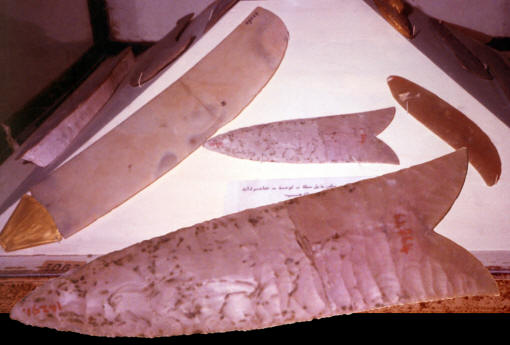
PHOTO BY DAN THEUS, CAIRO MUSEUM,
COMPUTER ALTERED IMAGE.
LATER TYPE FISHTAIL BIFACE &
GERZEAN
KNIVES
PREDYNASTIC PERIOD
EGYPT
These
Predynastic artifacts are on display in the Cairo Museum. The
fishtail biface has been enlarged for better viewing. This example
is a later version that dates to sometime
during the Naqada II period to the beginning of the Naqada III
period between 5,500 and 5,300 years ago. This type is easily
identified by the notch pattern at the center of the concave end.
Later versions of fishtail bifaces have a v-shape rather than a
u-shape. The "wings" or edges on either side of the center notch are
also excurvate, which is an added feature that gives them more of an
artistic look. Later fishtail bifaces also have sharper points on
the hafting ends and they are generally longer than the earlier
examples. |
|
|
Fishtail bifaces date to an early period in Egyptian history,
long before the first pyramids. They were used during the Predynastic
Naqada I-II periods and into the beginning of the Naqada III period. They
date to an approximate time span of between 6,000 years ago and 5,050
years ago. Later examples of these tools were made from different
materials. |
|
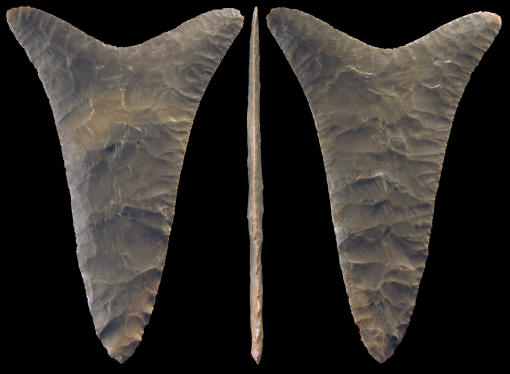
CLICK ON PICTURE FOR LARGER IMAGE
EARLY TYPE FISHTAIL BIFACE
PREDYNASTIC PERIOD
EGYPT
This Fish Tail biface represents a product made by a highly skilled
craftsman. It was made at a time when stone tool making in Egypt had
reached a golden age of flintknapping. It dates to sometime during the Naqada I period to the
beginning of the Naqada II period between 6,000 and 5,500 years ago.
These earlier types have smooth curving concave edges on their
working ends and rounded or blunted points on their hafted ends. The
edges are also concave. Some examples are reported to have been
steeply beveled on both edges, near the end, for hafting. It
measures 4 1/2 inches (11.4cm) long, 2 15/16 inches (7.5cm) wide and
3/16 of an inch (5mm) thick. |
|
|
There are two different types of fishtail bifaces. Both types have
a flared and concave working end and are widest opposite their hafted
ends, which is unique for flaked stone bifaces. The earliest examples
have smooth curving u-shaped concave edges on their working ends and rounded or
blunted points on their hafted ends. The side edges are also concave. Some
examples are reported to have been steeply beveled on both edges, near
the end, for hafting. |
|

FISHTAIL BIFACES
EARLY AND LATER PERIOD TYPES
PREDYNASTIC PERIOD
EGYPT
These five fishtail bifaces date to
the Predynastic period in ancient Egypt between 6,000 and 5,300 years.
Two different types have been identified. The examples on the right and
the left represent the earliest type and the three in the center are
more recent. The later type has a more pronounced v-shaped notch in the
center of the fish tailed end. The earlier examples have a more uniform
u-shape. The later fishtail bifaces also tend to be longer and they are
usually made from a lighter colored chert that is described as caramel
or light brown, like the restored example, fourth from the left. The two
red examples may be off color from the photograph. Earlier fishtail
bifaces were made from dark gray chert of good quality that may have
been collected in tabular form. |
|
|
Later versions of fishtail bifaces have a more complex design
pattern than the earlier examples. They are easily identified by their
more abrupt notch pattern at the center of the concave end. They have
more of a v-shape rather than a u-shape. The "wings" or edges on either
side of the center notch are also excurvate, which is an added feature
that gives them more of an artistic look. The later fishtail bifaces
also have sharper points on the hafting ends and they are generally
longer than the earlier examples. |
|

CLICK ON PICTURE FOR LARGER IMAGE,
BROKEN SEGMENT
LATER TYPE FISHTAIL BIFACE
PREDYNASTIC PERIOD
EGYPT
This picture shows two computer
altered images of a later type fishtail biface. This example was
broken more than midway to the hafting end that might suggest it was
damaged from use. The lower picture shows how it may have looked before
it was broken. The upper example is hafted with a gold handle. Some
fishtail bifaces were probably hafted onto very finely crafted handles
that might compare to those found on Predynastic Gerzean
knives that were made of ivory and gold. |
|
|
Most of the earliest fishtail bifaces are reported to have been
made from a dark gray chert of good quality that may have been collected
in tabular form. The more recent fishtail bifaces were made from a
lighter colored chert that is described as caramel or light brown. |
|
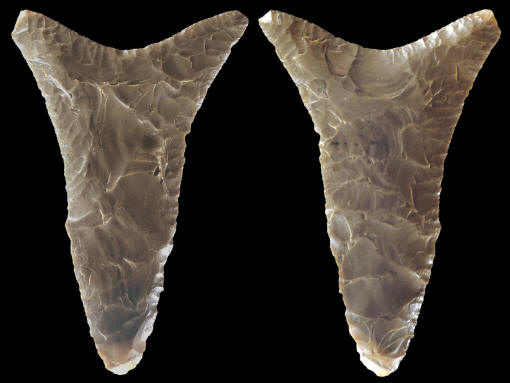
CLICK ON PICTURE FOR LARGER IMAGE
EARLY TYPE FISHTAIL BIFACE
PREDYNASTIC PERIOD
EGYPT
This fishtail biface is a classic example of an early style.
Although it's more crude than other examples and has some damage on
the tips of its "wings," it does have some areas of fairly well done
parallel pressure flaking. There is also an area where it was ground
prior to its final stage pressure flaking. It measures 4 1/8 inches (10.4
cm) long. |
|
|
Fishtail bifaces were manufactured by very skilled
craftsmen. The goal seems to have been to produce a biface with a very
flat cross section and very fine and thin edges. The preforms were
shaped and thinned with percussion. Further thinning of the preform and
straightening of the edges was done with pressure flaking and, in some
cases, grinding. Grinding was used to flatten out the upper side of a
preform then later pressure flaking removed most of the grinding.
Particular attention was paid to the edge detail of fishtail bifaces.
Some of them are finely serrated. Bruce Bradley described an average of
thirty three serrations per inch from examples in a museum in Cambridge.
Predynastic knappers did have access to copper and they most probably
used pressure flakers made of copper. There is also evidence that
attempts to remove unsightly hinged stacks, ridges, humps or any other
imperfections were done with the additional process of using punch flaking and grinding. |
|
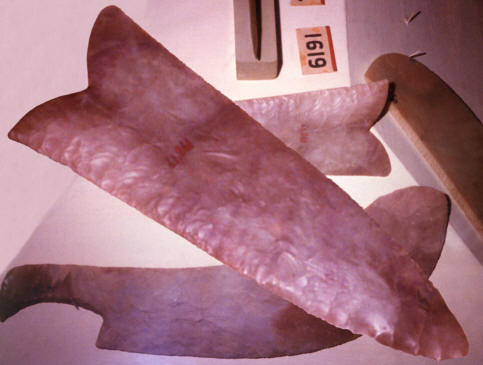
PHOTO BY DAN THEUS, CAIRO MUSEUM,
COMPUTER ALTERED IMAGE.
LATER TYPE FISHTAIL BIFACE
PREDYNASTIC PERIOD
EGYPT
This picture shows another
excellent example of a later type fishtail biface on display in the
Cairo Museum. It appears to have very fine edge work in the form of
micro serrations. The fish tail is expertly flaked into an artistic shape with a
classic v-notch center and excurvate "wings" on each side of the notch. |
|
|
Fishtail bifaces are rare. One estimate places the known
examples at about 160. It's believed that some fishtail bifaces were hafted onto very finely
crafted handles. The handles might compare to some of those found on
Predynastic Gerzean knives that were made of ivory and gold. |
|

CLICK ON PICTURE FOR LARGER IMAGE
LATER TYPE FISHTAIL BIFACE
MAGNIFIED VIEW OF SERRATED EDGE
PREDYNASTIC PERIOD
EGYPT
This magnified segment shows a portion
of the micro serrated edge of a later type fishtail biface. Tiny
serrations are one of the identifiable traits that are observed on many of these finely
crafted artifacts. Pressure flaking was probably done with copper. Bruce
Bradley (1972) described an average of thirty three serrations per inch
from examples in a museum in Cambridge. |
|
|
Fishtail bifaces are thought to have been used in the
"Opening of the Mouth" ceremony. The shape of the blade, that resembles
a fishes tail, is similar to more recent tools that appear in scenes of
funeral processions on the the walls of tombs of the Nobles. The
"Opening of the Mouth" ceremony was used to reanimate people who had died
so the deceased's soul could receive sustenance in the tomb. But
the ritual was also performed on statues of gods, kings and private
individuals and temples and Apis bulls (a
bull deity worshiped in the Memphis area).
The effect was intended to allow these inanimate objects to eat, breath
and hear so they could enjoy the offerings provided them by the
religious cult. |
|
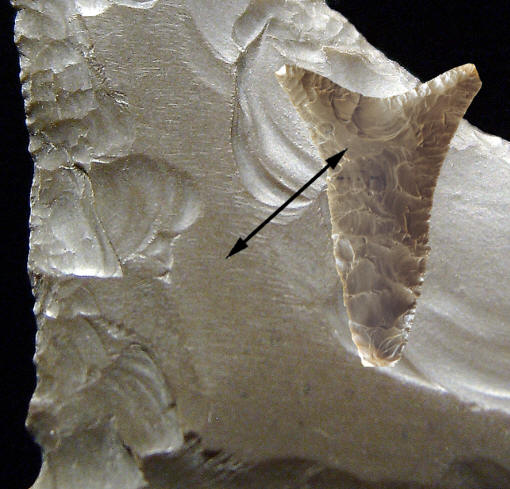
EARLY TYPE FISHTAIL BIFACE
GRINDING MARKS
PREDYNASTIC PERIOD
EGYPT
This magnified view shows a
small area on an early fishtail biface that was ground smooth. Grinding
was used to flatten out the upper side of some preforms then most of the
grinding was removed by final shaping of the biface with
pressure flaking. There is also evidence
that attempts to remove unsightly hinged stacks, ridges, humps or any
other imperfections were done with and grinding. |
|
|
The "Opening of the Mouth" ceremony was a complex ritual.
The earliest textual references date to the Old Kingdom 300 years or
more after the earliest suspected use of fishtail bifaces. As the ritual evolves over time
it becomes more complex. A thousand years later the ceremony is
represented by seventy five scenes in the New Kingdom version. There is no written documentation that proves fishtail bifaces were used
in the "Opening of the Mouth" ceremony during the Predynastic period.
But the
shape of the tool is the same as those depicted in later illustrations
of the ritual. So the evidence does seems to validate the existence of the ceremony
during this early period. Written text describes the moment when the fishtail biface is used, "the Sem priest brings an
instrument called the "pesh-en-kef," (fishtail
biface) and touches the mouth of the
mummy or statue therewith, and says, "O Osiris I have established for
thee the two jaw-bones in thy face and they are now separated, that is
to say, the bandages with which they have been tied up can no longer
prevent their movement when the deceased wishes to eat." |
|
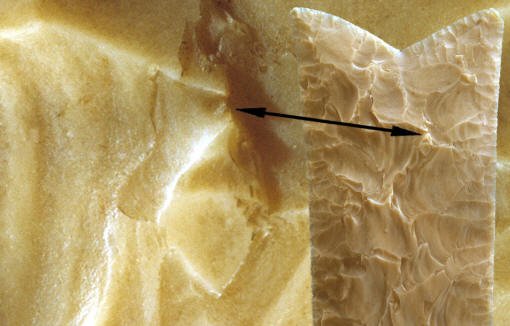
LATER TYPE FISHTAIL BIFACE
PUNCH FLAKE
REMOVAL
PREDYNASTIC PERIOD
EGYPT
This picture shows a
magnified view of a hinged stack where percussion flaking did not follow
through and remove an unsightly step fracture. It appears that an
attempt was made to remove some of the step fracture with a punch. This
process is fairly rare but it can be observed on ritual flint-work in
other areas of the world, such as large Aztec bifaces. |
|
|
Fishtail bifaces are one of the most unique stone tools that
were ever made and used before the "age of metal." The fact that they
were special is reflected in their quality of craftsmanship. If they
were in fact used to animate a persons spirit or soul, fishtail bifaces
must have been seen and respected as very special instruments indeed. |
|
"REFERENCES"
1972, Bradley, Bruce A., "Predynastic
Egyptian Flint Implements, An Inductive Technological Sequence,"
Newsletter of Lithic Technology, Vol. 1, No. 3, pp. 2-5.
1974?, first published 1899, Budge, Sir Wallis, "Egyptian Magic,"
pp. 197-198.
1984, Hoffman, Michael A., "Egypt Before The Pharaohs," p. 114.
2002, Redford, Donald B., "The Ancient Gods Speak: A Guide To
Egyptian Religion" pp. 293-296.
2009, Marquardt Lund, "Egyptian Flint Work, Part III," Chips, Vol. 21,
#3, pp. 5-7.
2009, Abeer el-Shahawy, " Egyptian Museum In Cairo: A Walk Through The
Alleys Of Ancient Egypt,
pp. 17-19.
From Personal Communications with Michael Allen Hoffman, PhD.
(deceased)
|
|
RECENT
LISTINGS HOME
ORDERING |